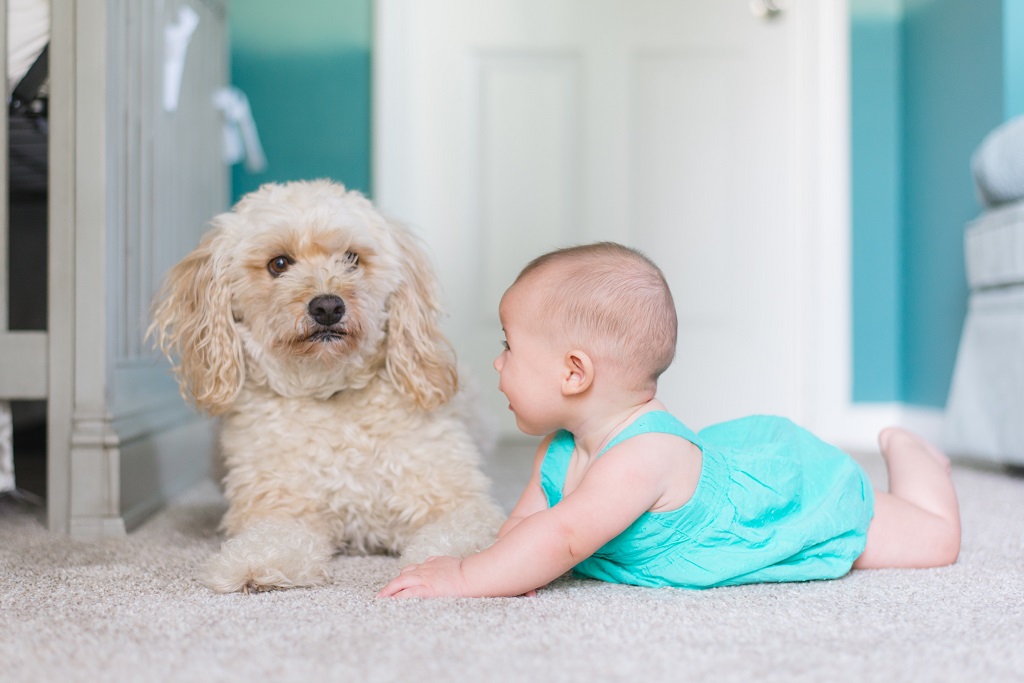Introducing Your Dog to Your New Baby
Your dog can likely sense that things are about to change in a big way when there is a baby on the way. So what can you do to help ease the transition for your furry friend?

When you're getting ready to bring a newborn baby into the family, it's exciting! A new little baby to hug, love and cherish forever. But your dog may not see it that way. Dogs can often feel confused, jealous or threatened by this new (tiny) family member coming into your home. And understandably so! Your dog can likely sense that things are about to change in a big way. So what can you do to help ease the transition for your furry friend? Keep reading to learn the top five tips for introducing your dog to your new baby -- so that everyone feels comfortable, included and loved.
1. Start getting your dog used to the baby before the baby even arrives.
You can do this by playing a recording of baby sounds in your house, beginning a few weeks before the baby arrives. These baby sounds can include crying, cooing, babbling, sighing, giggling... and more crying. This will allow your dog to get used to these new sounds so he isn't alarmed and frightened when he hears the real thing. You can even carry around a baby doll that cries and moves for a while before you bring home the real deal.
Another good idea is to get your dog acclimated to certain new "baby smells," including lotions, powders, diaper rash creams, formula and more. Let your dog sniff these things before the baby arrives so that these new smells aren't anything scary or intimidating once the baby comes home.
2. Once the baby is born, let your dog get used to the baby's scent before the actual introduction.
Every human has a unique smell that a dog needs to get used to. That's why it's a good idea to bring an article of the baby's clothing or one of his or her burp cloths or baby blankets home from the hospital before the baby comes home. Let your dog sniff it or lick it as much as possible. While your dog is doing that, pet him and give him lots of praise. Your dog will then associate this new baby smell with positivity and affection. Then, when the baby actually comes home, your dog will already know his or her scent.
3. For the first actual meeting, keep things pleasant.
Once your dog has been introduced to the new baby's scent via clothes, burp cloth or blanket, it's time for the actual meeting! To ensure that it goes as smoothly as possible, come into the house alone (without your new baby) to greet your dog. Pet him and give lots of affection. Tell your dog that his new baby brother or sister is about to come into the house. Let your dog get out all of his "I'm so happy you're home!" jumps and energy out before the baby comes in. Once your dog has been properly greeted and has then calmed down, it's time for the face-to-face meeting!
It can be a good idea to have your dog on a leash for this first actual meeting. This allows you to control your dog just in case he tries to jump on the baby or becomes aggressive (which is unlikely, but you can never be too careful).
Next, allow your dog to approach you and the new baby. Don't approach your dog. This allows your dog to feel like nothing is being forced, but instead that this new family member is innocent and harmless. When your dog does choose to meet the baby, let him sniff and then give lots of praise for a job well done. Treats, words of affirmation and hugs go a long way for your dog in this situation!
4. Don't let your dog feel neglected.
For so many couples, their dog was their "baby" before they had an actual baby. And even though there's a good chance your dog will love your baby just as much as you do, that doesn't mean that he won't need some time to adjust to this new normal.
As your dog transitions to life with a "sibling," make sure he knows that you still care for him just as much as you always have! You can do this by giving him a new chew toy or some new treats. If he begins barking more or getting in trouble more than usual, redirect his behavior and give him one of his new toys or treats. This will both redirect his attention and let him know that you still love him very much!
In addition, don't forget to give your dog plenty of attention and exercise after the baby arrives. Although you won't be able to give him as much as you did before, it's a good idea to give him as much attention and exercise as you can so that he doesn't feel upset by this new normal.
5. Foster a good, healthy relationship between your dog and your baby.
Dogs are known as man's best friend for a reason. They are generally loyal, kind and loving to their humans. To keep this relationship positive, teach your baby to be gentle with your dog from the very start. Show your baby how to pet the dog nicely and be gentle and respectful.
Last, never leave your baby alone with your dog. Even if you think your dog would never hurt your baby, unfortunately, surprises and accidents like this can happen with nearly any breed of dog. Supervise all interactions and keep an eye out for any unusual behavior from your dog, such as growling, pacing or unusual eye contact. Dogs don’t understand how delicate a baby is, so they can accidentally hurt a baby just by seeing what's going on when he or she has a new sound or smell.
Ready to make the introduction?
As you get ready to introduce your dog to your new baby, go into it with a positive attitude. Almost every dog can learn to get along with a new baby, especially with a proper introduction.
Bringing your new baby home to a house with a pet will help improve your child's life in the long run. Having a dog decreases the chances that your baby will develop anxiety, teaches your baby about responsibility as he or she grows and teaches your child to be kinder and gentler. Plus, your dog will reap all of the many benefits of living with a loving family. What more could you ask for?
Ready to start saving money on pet wellness care?
Then take a look at Mint Wellness, the pet wellness plan that provides fast reimbursement on routine pet care. Save on vaccinations, wellness exams, preventatives, dental, and more!
Learn More


